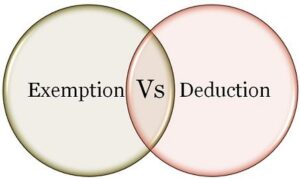 Before filing your income tax return (ITR), it’s crucial have clarity on deductions and exemptions. Understanding these distinctions can significantly impact your tax liabilities and savings.
Before filing your income tax return (ITR), it’s crucial have clarity on deductions and exemptions. Understanding these distinctions can significantly impact your tax liabilities and savings.
The deadline for filing your income tax return (ITR) for FY23-24 is July 31, 2024. While taxes may seem like a complicated maze, there are avenues available that can help alleviate the burden — tax deductions and exemptions.
These provisions help taxpayers by reducing their taxable income and overall tax liability.
Tax deductions are concessions allowed by the Income Tax Department, reducing an individual’s gross total income.
“These deductions can be claimed for various reasons such as donations, business expenses, and contributions to provident funds. However, they are subject to specific provisions and circumstances outlined in the Income Tax Act,” said Megha Jain, Tax Expert at Cleartax.
On the other hand, tax exemptions refer to portions of income that are not taxable.
These exemptions, such as interest income from PPF or long-term capital gains reinvested in specified assets, can significantly reduce one’s tax liability.
Taxpayers must consider specific provisions and circumstances when claiming deductions and credits.
According to Jain of Cleartax, eligibility criteria vary based on factors like marital status, income level, and other considerations.
Therefore, careful consideration of these criteria and proper documentation preparation are essential for claiming deductions and credits accurately.
Tax deductions can be broadly categorised into three main groups:
Deductions regarding certain payments: This category includes expenses related to medical and life insurance premiums, charitable donations, etc.
Certain outcome deductions: These deductions are based on specific income types, such as royalty on patents or income from cooperative societies.
Other deductions: This category encompasses expenses like home office expenses, education expenses, and contributions to retirement accounts.
Claiming tax deductions and credits involves following prescribed filing procedures and maintaining proper documentation.
“Taxpayers must complete relevant sections of the tax return and attach necessary supporting documents, such as receipts and invoices. Failure to provide adequate documentation or meet eligibility criteria may lead to denial of deductions or credits, resulting in higher tax liabilities,” Jain said.
| Aspect | Tax Deductions | Exemptions |
| Definition | Certain expenses or investments that reduce taxable income. | Specified amounts or allowances that reduce taxable income. |
| Nature | Based on specific expenses or investments. | Fixed amounts or allowances provided irrespective of expenses. |
| Purpose | Encourages certain behaviours (e.g. investments in specific sectors, charitable donations). | Provides relief from tax liability for basic needs (e.g. HRA, LTA, standard deduction). |
| Examples | Investments in ELSS (Equity Linked Savings Scheme) | House Rent Allowance (HRA) |
| Health Insurance Premiums | Leave Travel Allowance (LTA) | |
| Donations to approved charitable institutions | Standard Deduction | |
| Education Loan Interest | Conveyance Allowance | |
| Applicability | Depends on actual expenses or investments made by the taxpayer. | Available to certain categories of taxpayers regardless of actual expenses incurred. |
| Limits | Subject to maximum limits specified under the Income Tax Act. | Generally fixed amounts with specific conditions for eligibility. |
| Documentation | Require supporting documents (e.g. receipts, certificates) to claim. | Generally, no specific documentation required; automatically provided based on employment or status. |
| Impact on Taxable Income | Directly reduces taxable income. | Directly reduces taxable income. |
| Reporting Requirement | Need to be claimed by the taxpayer while filing income tax returns. | Automatically considered while calculating taxa |
Source: https://www.cnbctv18.com/personal-finance/income-tax-return-itr-filing-deductions-vs-exemptions-investments-ppf-lta-hra-elss-insurance-19427427.htm
© 2018 CA Chandan Agarwal. All rights reserved.